Twitter Is Actively Contributing to the Spread of Serious Self-Injury
And suppressing those calling attention to it
Nearly a quarter of girls between 12 and 16 are intentionally injuring themselves, mostly with knives and razor blades. The rate is even higher among teens from upper-middle class, highly educated families. Those who self-harm are six times more likely to be hospitalized for mental illness than those who don’t and more than four times as likely to attempt suicide. According to the National Institute of Mental Health, suicide is now the second leading cause of death among children 10-14 and the third leading cause of death among those 15-24.
Self-harm is a social contagion — one of many — that is fed by social media. My colleagues and I at the Network Contagion Research Institute (NCRI) published a paper on August 29 exposing the increase in the number of accounts posting graphic self-harm images and videos (specifically “cutting”). Posting graphic depictions of self-harm in order to celebrate it is a direct violation of Twitter’s content policy, as are comments that encourage self-harm. Yet these images and comments are easy to find. Twitter’s algorithm even suggests them to those whose history on the platform involves looking at such posts.
On October 3, I criticized Twitter for how it deals with self-harm — specifically that Twitter does not enforce its “gratuitous gore” policy for self-harm images, nor does it enforce its policy of prohibiting tweets that “promote or encourage suicide or self-harm.” To illustrate how easy Twitter makes it to find posts with extremely graphic images and videos depicting severe self-harm (cutting), I tweeted some common self-harm codewords along with screenshots of a horrific self-harm post & accompanying comments.
In response, Twitter locked me out of my account (@PamelaParesky). They claimed I violated the same “gratuitous gore” policy I criticized them for not taking seriously. I am now using a new account (@PareskyPamela) while I await a resolution.
One might argue that because my complaint was about the troubling accessibility of self-harm images, I should be happy that Twitter applied its “gratuitous gore” policy to take mine down. However, not only is posting something in order to report on it not “gratuitous,” the self-harm tweet I screencapped is still accessible. It continues to contribute to the spread and increasing severity of self-harming behaviors.
My Problem With Twitter
My October 3 tweet quote-tweeted my NCRI colleague, Alex Goldenberg linking a Washington Post article summarizing our research into Twitter’s self-harm problem which ran the day after the publication of our report. Alex wrote, “Despite @ncri_io releasing the report highlighted in the @washingtonpost a month ago, Twitter has not made any meaningful efforts to disrupt this growing network that encourages children and young adults to severely harm themselves.”
I screencapped an extremely disturbing tweet with two photographs of severe self-harm (cutting) and also screencapped two comments encouraging such self-harm (“I want to eat the inside” and “Am i aloud [sic] to call it pretty? Because I think its [sic] really pretty looking”). I posted the three screenshots and included them in the quote-tweet, adding, “A cursory search for terms like shtwt beanstwt fasciatwt bloodtwt ... etc. turns up graphic images of self-harm and delighted responses encouraging more. (Images and comments below are extremely disturbing.) KEEP YOUR CHILDREN OFF SOCIAL MEDIA.” (The images in the screenshot below are blurred. They were not blurred in my tweet.)
After I was locked out, Alex Goldenberg looked to see if the original self-harm tweet whose images I posted was still up. (It was.) While he was looking, Twitter suggested to him the self-harm tweet below (“you might like…”).
On October 3, the tweet that Twitter suggested to Alex had 6 retweets, and 82 likes and 6 comments. On October 14, thanks to Twitter, it had 137 retweets, 1,304 likes, and 26 comments, including many versions of “so cool.” The account has only 223 followers.
In response to one admiring comment asking how the above self-harm was accomplished, the self-harmer posted instructions for how to make a common disposable razor “more easy to handle” in order to use them for self-harm.
Twitter is actively contributing to the spread and increasing severity of serious self-injury.
My tweet — the one that resulted in my lockout — had one like and zero retweets before I lost access to my account. At that time, the original post I screencapped had roughly 1800 likes and 250 retweets. It is now the account-holder’s pinned tweet.
On October 5th, two days after my lockout, the self-harming account holder tweeted the “stats” of the original post. At that time, it had been up for one week. It had 2240 likes, 287 retweets, and 80 comments. It had resulted in 1,229 detail expands, 4,440 profile visits, 13,291 engagements, and 67,332 impressions — in other words, it was seen a total of 67,332 times within a week. As of the last time I checked, it had garnered 2625 likes, 321 retweets, and 93 comments. Although @PamelaParesky has more than ten times the followers of the self-harm account that tweeted that post, I don’t know of any of my tweets attracting that kind of engagement or number of impressions.
This aligns with what we reported in our NCRI paper. Self-harm posts can garner thousands of likes, hundreds of retweets, and dozens of admiring comments, including many with questions about how to duplicate the self-harm (e.g. “what did you use?”). The high level of engagement these posts attract can rival tweets from accounts with tens of thousands of followers — though many self-harm tweets with high engagement, like the one Twitter suggested to my colleague, come from accounts with fewer than 300 followers. And many are quasi-instructional.
My first appeal to Twitter to let me back into my account was quickly denied.
Over the next few days, I tried to appeal several more times but I received no further communication from Twitter. I appealed again on October 14 and received confirmation that my newest appeal was received.
If Twitter continues to reject my appeals, I must go through a series of steps to “delete” that tweet –– which is no longer visible on Twitter.
Why would Twitter require me to delete a tweet that no one can see?
Unlocking an account by deleting a tweet Twitter entails assent to having violated Twitter’s terms of service:
Illustrating Twitter’s inability to deal with the problem of gratuitous gore circulated and celebrated on the platform by posting an image of such gore is definitionally not “gratuitous.” I will not falsely confess to having violated Twitter’s terms in order to access my account. I therefore continue to be locked out and must use the new account (@PareskyPamela) unless and until the issue is resolved.
Twitter’s Self-Harm Problem
Adolescence is hard. It is also a time of particular susceptibility to social contagion. Not only do young people learn through imitation, but belonging is an exceptionally salient need in adolescence. When today’s parents of teens were young, there were teens who engaged in cutting themselves. But it was less prevalent. My anecdotal sense is that anyone in their fifties today knew no more than one person who intentionally cut themselves as adolescents. It is common for today’s young people to know more than three.
Before social media, social contagions were limited and weren’t easily “gamified.” The tweet below represents a competition in which members of Twitter’s self-harm “community” voted on their favorite of two self-harmers. (The winner of this vote was the one who posted the photos I was locked out of Twitter for tweeting.)
In October of 2021, 5Rights, a UK-based children’s digital rights charity, reported that Twitter and other platforms were, as we noted in the NCRI paper, “systematically endangering children online” by facilitating children’s ability to connect with others celebrating self-harm. Specifically, Twitter’s algorithmic recommendation system was steering accounts with child-aged avatars searching the words “self-harm” to Twitter users who were sharing photographs and videos of cutting themselves. The organization told Twitter about specific self-harm search-terms like #shtwt, #ouchietwt, and #sliceytweet.
Ten months after Twitter was informed, we documented a 500% increase in average mentions of shtwt, the global search-term for “self-harm twitter.” Other search-terms that help people find bloody self-harm images also rose in prevalence. As we wrote in our report, terms associated with layers of skin such as styrotwt, beanstwt, laffytaffytwt, and others are mentioned thousands of times per month allowing users to gamify and market self-harm. Wounds associated with “beanstwt” tweets [referring to the subcutaneous layer] are extremely severe. These are often the tweets and images most liked and shared.
In our paper, we describe coded search-terms: “babies” for the lightest cutting and “beans” for cutting down to the subcutaneous layer. (The image below explains codewords for depth.) Simpler terms like “gore,” “gory,” “blood,” “scars”… etc. are also used. Other coded terms refer to the way the injuries look. For example, “catscratch,” “raspberryfilling,” “barcode,” and “armgills.” All of these terms are often appended with “twt.”
On August 30, the Washington Post published a news article about our paper. Twitter responded by making the 988 Suicide and Crisis Lifeline appear at the top of search results whenever someone types “shtwt” in the search bar. (In September, “shtwt” was mentioned 26,000 times.)
One might conclude that Twitter took reasonable action by ensuring that a helpline appears. The 988 information does not appear, however, when searching for the other coded terms we revealed in our report. Worse still, when someone searches for shtwt, immediately under the helpline information, graphic images and videos of self-harm (“gratuitous gore”) still appear.
Soon after Twitter began showing the 988 helpline at the top of shtwt search results, “988twt” became a new and popular self-harm search term, tweeted hundreds of times per hour to tag horrific self-harm posts — including the one I screencapped (which was tagged with 988twt, shtwt, beanstwt, fasciatwt, bloodtwt, and scartwt).
Putting “988” in the Twitter search bar now calls up not just the help-line, but self-harm posts and memes. And these appear in the search results above the 988 Suicide & Crisis Lifeline.
On October 15, this tweet below was appearing immediately under the help-line when searching “shtwt.” Within two days it had 1304 likes, 149 retweets, and 57 comments. The posting account has only 41 followers.
Twitter and other platforms may need the help of other organizations who can scout for posts that pose legitimate risks of harm and delete them. It has not sought it out. If Twitter enforced its policies about self-harm with a fraction of the zeal with which it censors the viewpoints it deems “harmful,” it would cease to be a self-harm accelerator and might even disrupt the formation of online self-harm “communities.”
To be clear, I am not advocating for censorship. I am suggesting that as long as Twitter enforces any of its terms, it must enforce all of them. If Twitter’s terms of service include prohibitions on self-harm images and comments that encourage self-harm, it should enforce those prohibitions.
As of this essay’s publication, I will have been locked out of my Twitter account for two weeks and counting while I await Twitter’s adjudication of my case.
Parents, get your kids off Twitter.
Twitter, get your act together.
Pamela Paresky, PhD, is a psychologist, a Visiting Fellow at the Johns Hopkins SNF Agora Institute, a Senior Scholar at the Network Contagion Research Institute, a frequent online contributor to Psychology Today, and the author of the guided journal, A Year of Kindness. Dr. Paresky's opinions are her own and should not be considered official positions of any organization with which she is affiliated. Follow her on Twitter @PareskyPamela until her @PamelaParesky account is unlocked. Her newsletter is at Paresky.Substack.com.




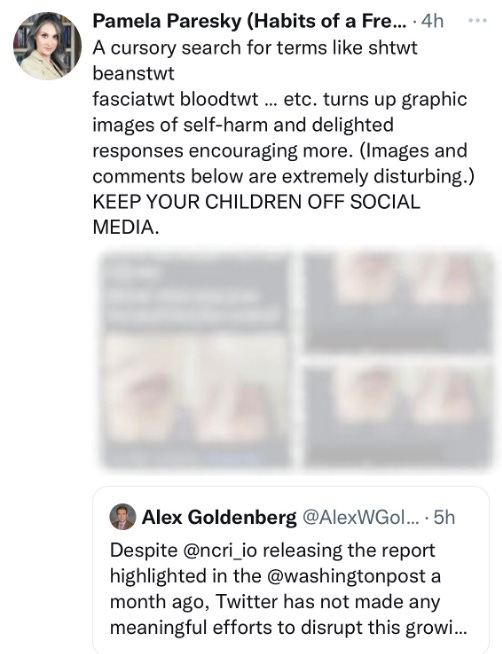
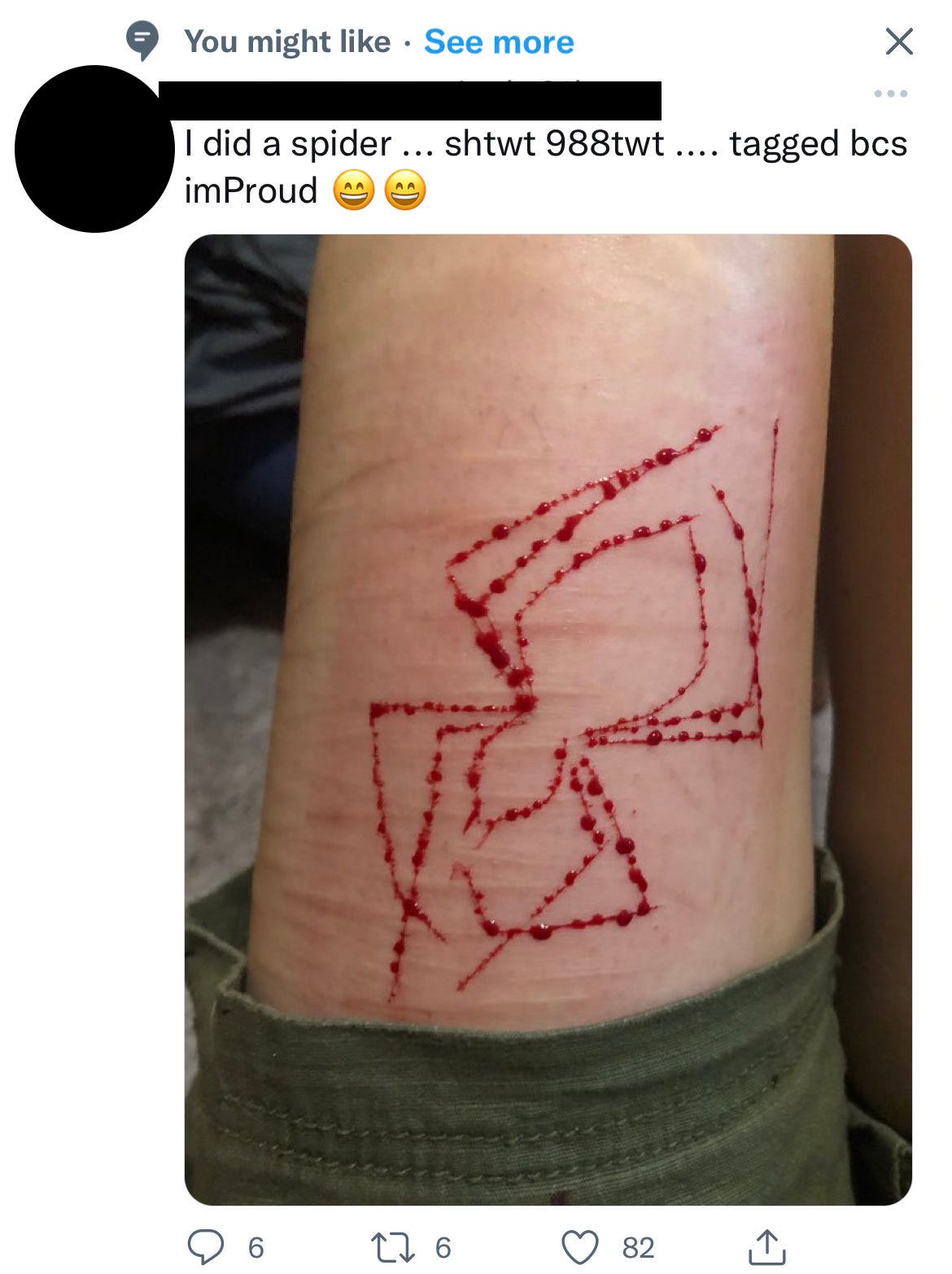

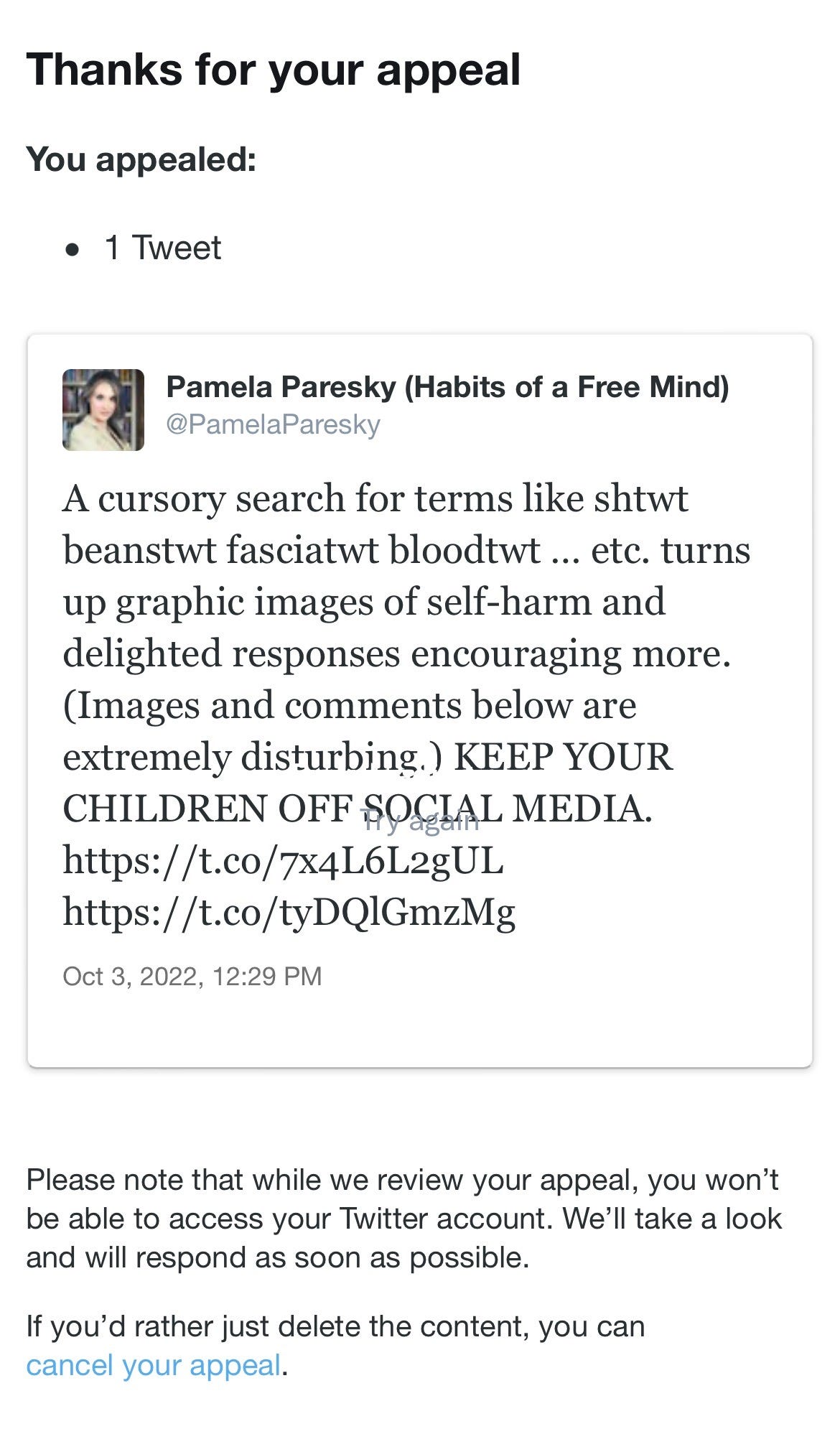




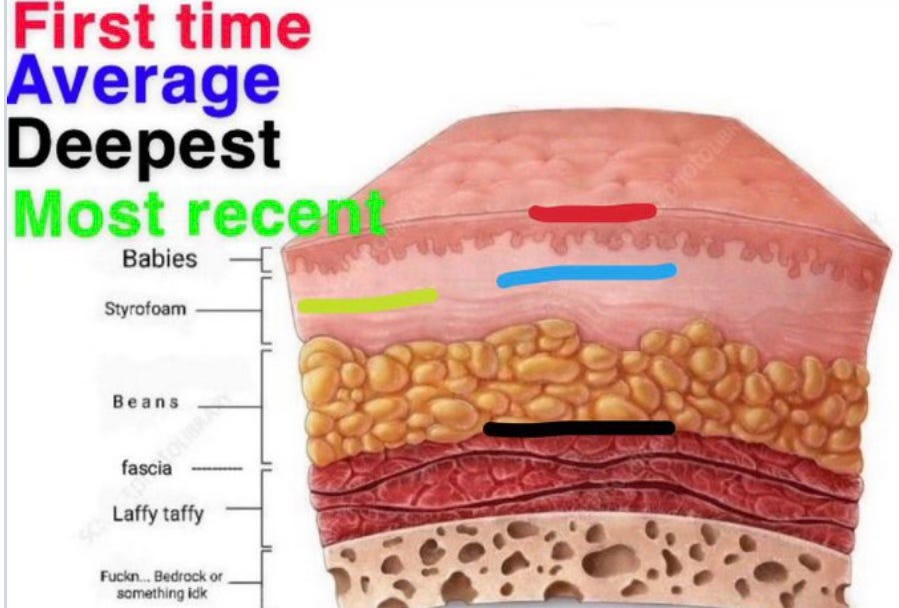
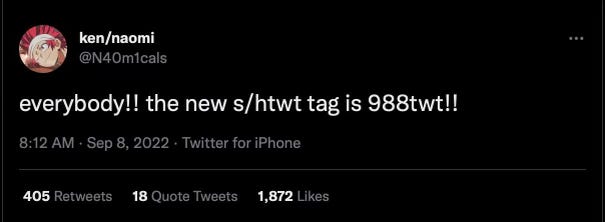
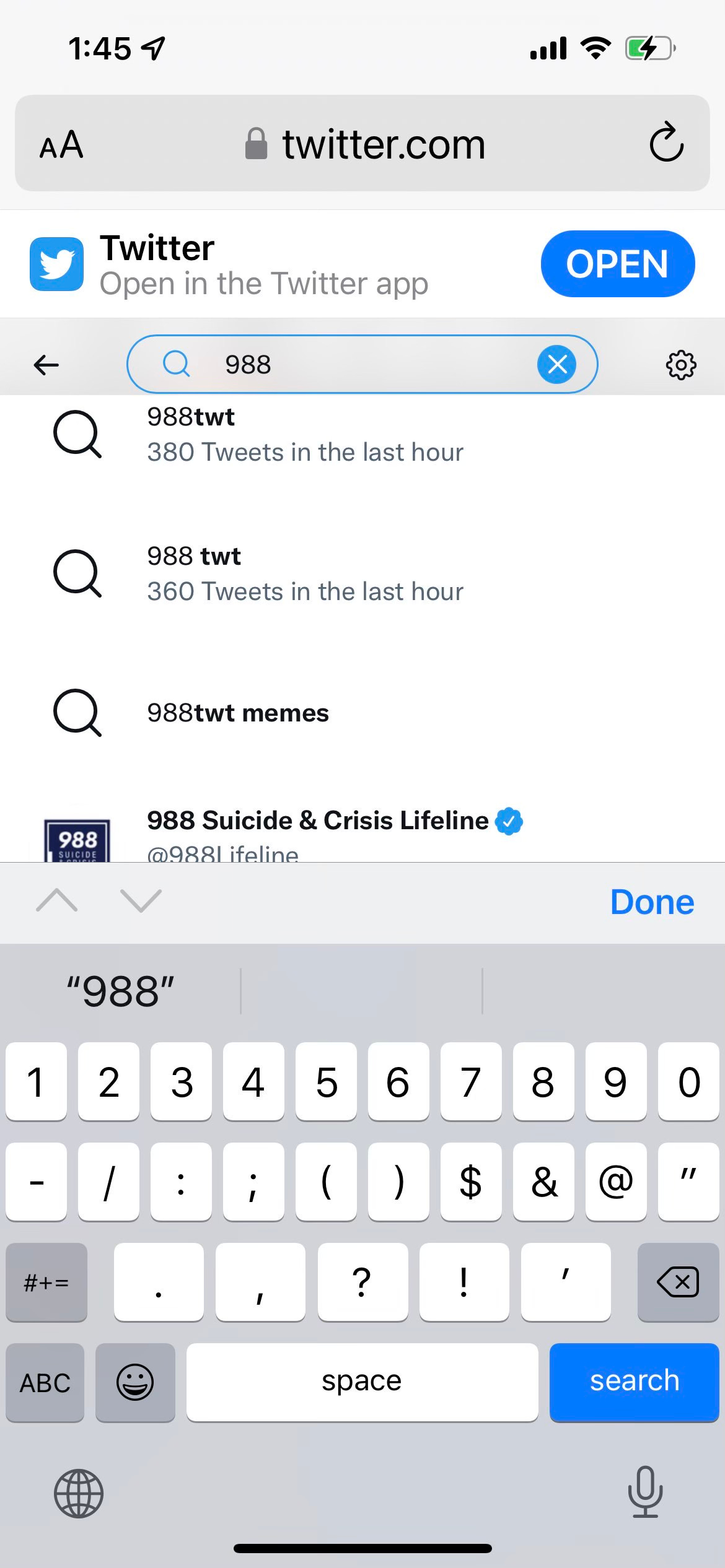
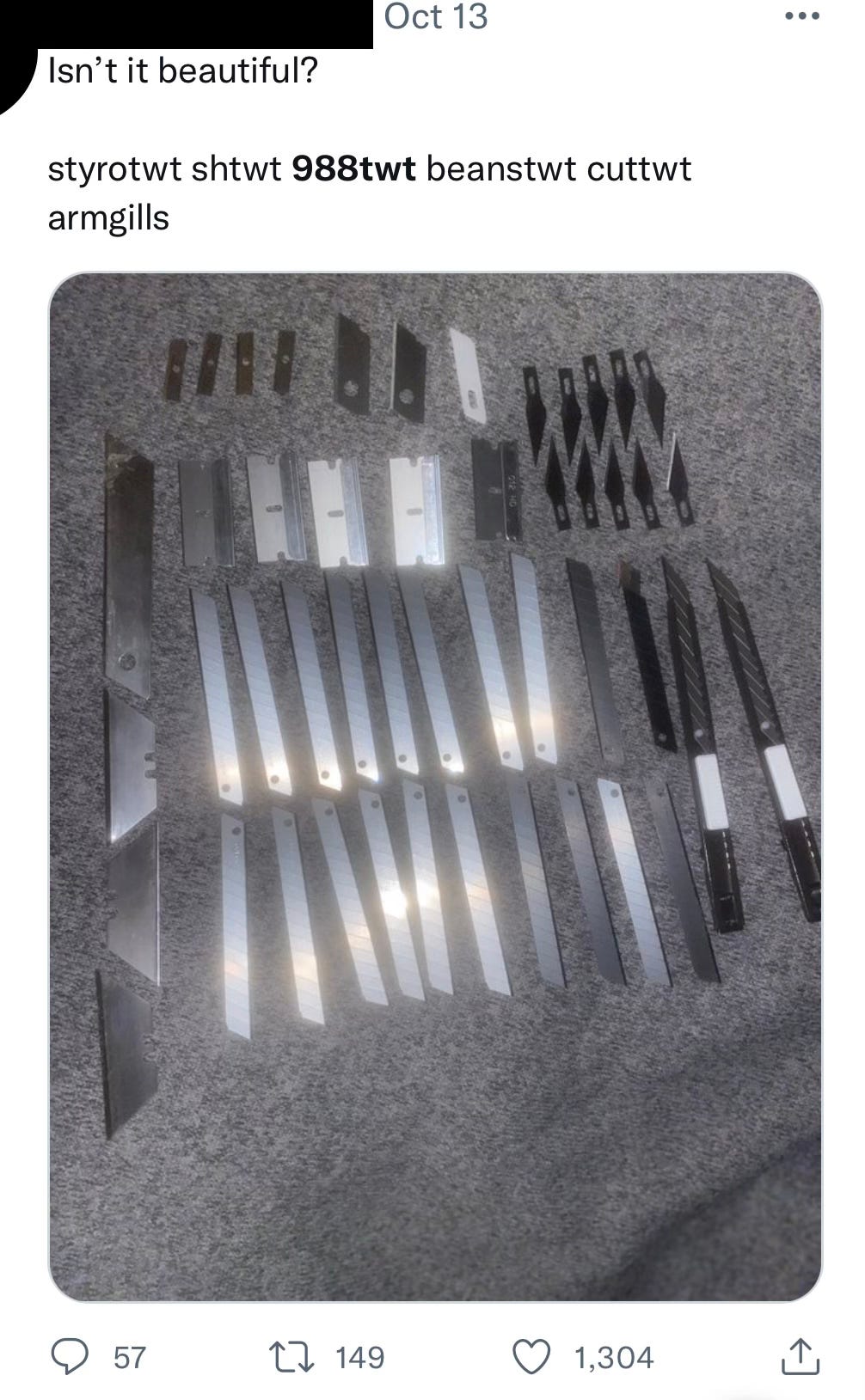
This is important information and as a parent alarming, thank you for doing this research
However I was disappointed to see that the other NCRI reports were focused on apparent calls for censorship of political and COVID related viewpoints, which to me raise very different issues
Is anyone really surprised? Family and conscious stewardship of the child destroyed. Meaningful life distorted and denied. The mad house pathological manufacture of anxiety, depression, obfuscation and manipulation in service to international criminal capital. A compromised revolving door "pay-to-play" political leadership lining its pockets.
Like all issues of vital human social concern to American's and the World, international criminal capital demands, that the child, because it is the future, be captured, molded and controlled. How different is the instilled pathological depression, fear, insecurity and anxiety of a child cutting deep into "beans" from the monstrous pathology of a mercenary medical profession drugging and hacking at the body of confused adolescents. Is this butchery any different from the hubris of the inhuman fiends who rationalized the creation of the "castrati" ? We have departed the political and are squarely in the realm of the pathological.
Controlling and encouraging the self-harm and butchery of the CHILD is an exercise in power and control. The message is clear. "WE have power. YOU DON'T". How shocked and surprised can we be at the complicity of ideological utopian "twits" and their willingness to encourage and exploit the destruction of the young when the people they serve openly display Julian Assange as an object lesson to the world. If I can, independently of your elected government, assess fines, seize your bank account and silence you at will do I give a f'k if your child is in peril. YOU ARE A THING to be exploited for my purposes and nothing more.
Isolation. Anxiety. Depression. Disconnection from a loving human moral community. The suicidal cry for help. Anomie and distortion. Addiction. Homelessness. Propagandized hysteria and disinformation. Irrational crime and murder. This is now a static American reality. The totalitarian dystopia ascends. The biggest LIE we tell ourselves is that it isn't happening.